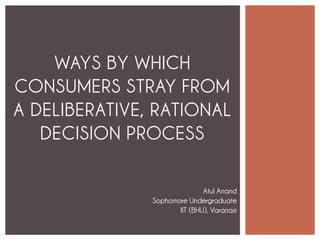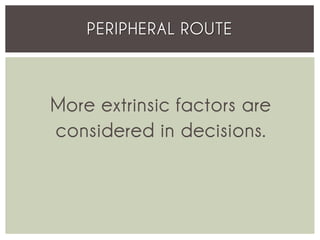Ways by which consumers stray from a deliberative, rational decision process
- 1. WAYS BY WHICH CONSUMERS STRAY FROM A DELIBERATIVE, RATIONAL DECISION PROCESS Atul Anand Sophomore Undergraduate IIT (BHU), Varanasi
- 2. LOW INVOLVEMENT CONSUMER DECISION MAKING VARIETY SEEKING BUYING BEHAVIOR MAIN FACTORS FOR STRAYING
- 4. EXPECTANCY VALUE MODEL Requires high level of consumer involvement.
- 5. ELABORATION LIKELIHOOD MODEL Richard Petty & John Cacioppo Consumer evaluation in both high and low involvements
- 6. ELABORATION LIKELIHOOD MODEL Two means of Persuasion Central Route and Peripheral Route.
- 7. CENTRAL ROUTE Must posses sufficient motivation else not pursued as detailed examination is required for purchase.
- 8. PERIPHERAL ROUTE More extrinsic factors are considered in decisions.
- 9. If low involvement to high is not converted, consumer will follow peripheral route and not the central route.
- 10. CONVERSION OF LOW TO HIGH INVOLVEMENT FOUR TECHNIQUES Link to an engaging issue. Link to a personal situation. Design ad to trigger emotion. Addition of important features.
- 11. Marketers must try to convert to persuade the consumer to follow the central route (favorable for weaker brands)
- 13. Low involvement but significant brand differences
- 14. Consumers often switch brands to evaluate the variety and not because of dissatisfaction.
- 15. Dominate the shelf with variety to encourage habitual buying behavior.
- 16. Free coupons, deals, low prices, free samples, etc.
- 17. These results in a deliberate and rational decision making.
- 19. Consumers choose an alternative after a relatively inferior option is added in to the available choice set.
- 20. Consumers are not sure about their future taste.
- 21. Consumers often overestimate future consumption, especially if there is limited availability.
- 22. Consumers choices are influenced by subtle changes in the ways alternatives are described.
- 23. These were non compensatory decision strays.
- 24. Marketers can use these findings to counter straying of there brands. STRATEGY
- 25. Customers segregate gains. Consumers are forced to consider different benefits separately by the seller. (Listing different benefits can make the sum to be seen greater as a whole) MENTAL ACCOUNTING OF CUSTOMERS
- 26. Customers integrate losses. Customers buy if the cost can be added to another larger purchase. (Additional features persuade customers to buy high end products) MENTAL ACCOUNTING OF CUSTOMERS
- 27. Customers integrate smaller losses with larger gains. ŌĆ£CancellationŌĆØ principle works here. (Smaller withholdings are absorbed by larger pay amounts) MENTAL ACCOUNTING OF CUSTOMERS
- 28. Customers segregate smaller gains with larger losses. ŌĆ£Silver liningŌĆØ principle works here. (Rebates on big-ticket purchases such as cars) MENTAL ACCOUNTING OF CUSTOMERS
- 29. Consumers exhibit low involvement using many heuristics as a result of contextual influences. SUMMARY
- 30. THANK YOU






























